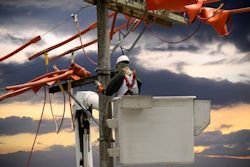Exception to Minimum Clearance
If it is impossible to perform a lift while staying the required minimum distance from a power line, as specified in Table A, the standard provides an exception that allows operations closer than the minimum distance.
You must verify that an alternative method of performing the lift will not be possible. You must consult the utility that owns or operates the line to determine whether it is feasible to de-energize and ground or relocate the line.
If de-energizing/grounding or relocation is not feasible, may you operate closer to an energized line than the minimum distance. However, you must conduct a planning meeting with the power line owner/operator or a qualified registered professional engineer who can determine the minimum clearance distance in light of the on-site conditions.
The factors that must be considered in making this determination include, but are not limited to:
- conditions affecting atmospheric conductivity;
- time necessary to bring the equipment, load line, and load (including rigging and lifting accessories) to a complete stop;
- wind conditions;
- degree of sway in the power line;
- lighting conditions; and
- other conditions affecting the ability to prevent electrical contact.
Knowledge Check Choose the best answer for the question.
4-6. If necessary, who must be consulted to determine if it is feasible to de-energize and ground or relocate the line?
You forgot to answer the question!

